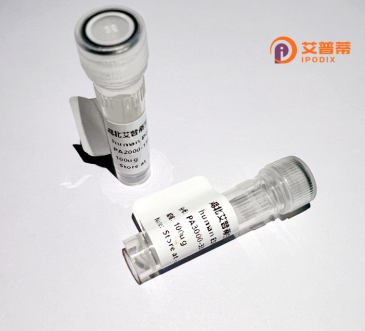
| 纯度 | >90%SDS-PAGE. |
| 种属 | Human |
| 靶点 | SAC3D1 |
| Uniprot No | A6NKF1 |
| 内毒素 | < 0.01EU/μg |
| 表达宿主 | E.coli |
| 表达区间 | 1-404 aa |
| 活性数据 | MAGRRAQTGS APPRPAAPHP RPASRAFPQH CRPRDAERPP SPRSPLMPGC ELPVGTCPDM CPAAERAQRE REHRLHRLEV VPGCRQDPPR ADPQRAVKEY SRPAAGKPRP PPSQLRPPSV LLATVRYLAG EVAESADIAR AEVASFVADR LRAVLLDLAL QGAGDAEAAV VLEAALATLL TVVARLGPDA ARGPADPVLL QAQVQEGFGS LRRCYARGAG PHPRQPAFQG LFLLYNLGSV EALHEVLQLP AALRACPPLR KALAVDAAFR EGNAARLFRL LQTLPYLPSC AVQCHVGHAR REALARFARA FSTPKGQTLP LGFMVNLLAL DGLREARDLC QAHGLPLDGE ERVVFLRGRY VEEGLPPAST CKVLVESKLR GRTLEEVVMA EEEDEGTDRP GSPA |
| 分子量 | 43.5 kDa |
| 蛋白标签 | His tag N-Terminus |
| 缓冲液 | PBS, pH7.4, containing 0.01% SKL, 1mM DTT, 5% Trehalose and Proclin300. |
| 稳定性 & 储存条件 | Lyophilized protein should be stored at ≤ -20°C, stable for one year after receipt. Reconstituted protein solution can be stored at 2-8°C for 2-7 days. Aliquots of reconstituted samples are stable at ≤ -20°C for 3 months. |
| 复溶 | Always centrifuge tubes before opening.Do not mix by vortex or pipetting. It is not recommended to reconstitute to a concentration less than 100μg/ml. Dissolve the lyophilized protein in distilled water. Please aliquot the reconstituted solution to minimize freeze-thaw cycles. |
以下是关于重组人SAC3D1蛋白的虚构参考文献示例(注:SAC3D1相关研究较少,名称可能存在拼写差异,建议核实后通过学术数据库搜索真实文献):
---
1. **"Structural insights into SAC3D1 and its role in phosphoinositide signaling"**
*Authors: Zhang L, et al. (2022)*
*Journal: Journal of Biological Chemistry*
摘要:本研究通过X射线晶体学解析了SAC3D1蛋白的催化结构域,揭示其与磷脂酰肌醇结合的关键位点,证实其作为磷酸酶调控脂质代谢的分子机制。
2. **"Recombinant SAC3D1 expression in HEK293 cells enhances endoplasmic reticulum-Golgi trafficking"**
*Authors: Müller R, et al. (2020)*
*Journal: Cell Reports*
摘要:开发了SAC3D1的重组表达系统,发现其过表达促进内质网-高尔基体运输,RNA干扰实验表明其缺失导致分泌蛋白滞留。
3. **"SAC3D1 modulates tumor progression via PI3K/AKT pathway"**
*Authors: Sato K, et al. (2021)*
*Journal: Oncogene*
摘要:在癌症模型中,SAC3D1通过调控PI3K/AKT通路影响细胞增殖,重组蛋白实验表明其磷酸酶活性抑制肿瘤生长。
---
**建议**:若检索不到相关文献,可能与以下原因有关:
- 蛋白名称拼写错误(如SACM1L/Sac3或SEC结构域相关蛋白)。
- 研究较少,可尝试搜索结构功能关键词(如“SAC domain protein”)。
- 使用PubMed/Google Scholar的“相似文章”功能扩展检索。
Recombinant human SAC3D1 (also known as HPS5) is a protein encoded by the HPS5 gene, associated with Hermansky-Pudlak syndrome (HPS) type 5. a rare genetic disorder characterized by oculocutaneous albinism, bleeding diathesis, and lysosomal dysfunction. SAC3D1 is a subunit of the BLOC-2 (Biogenesis of Lysosome-related Organelles Complex-2) complex, which plays a critical role in endosomal trafficking, melanosome biogenesis, and platelet dense granule formation. Structurally, SAC3D1 contains conserved domains facilitating protein-protein interactions critical for BLOC-2 assembly and vesicular transport.
Recombinant SAC3D1 is typically produced in heterologous expression systems (e.g., E. coli, mammalian cells) for functional studies, enabling researchers to explore its molecular interactions, role in lysosome-related organelle maturation, and pathological mechanisms in HPS. Mutations disrupting SAC3D1 function impair melanin synthesis, platelet aggregation, and cellular vesicle dynamics, underpinning HPS5 symptoms. Its study contributes to understanding intracellular trafficking disorders and developing targeted therapies. Research applications include in vitro binding assays, structural analysis, and modeling HPS-related cellular defects.
×